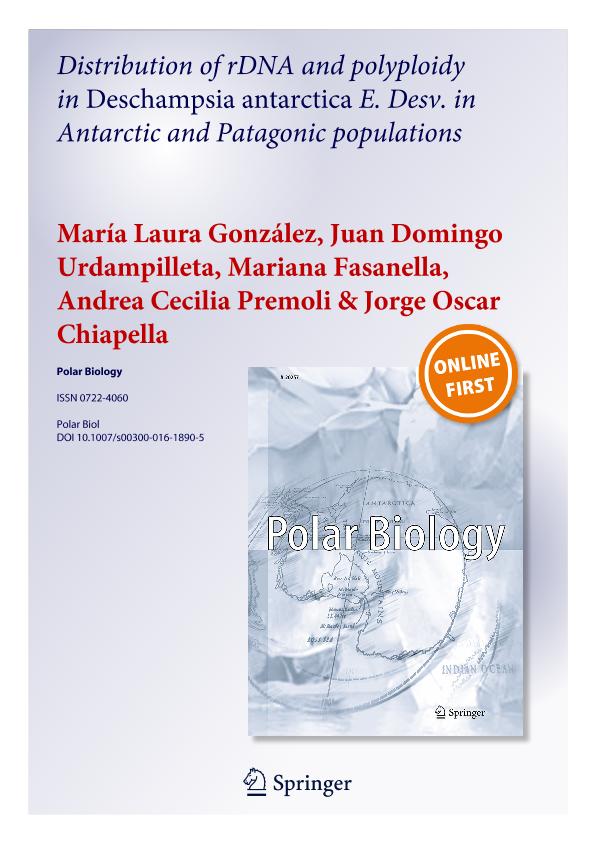Mostrar el registro sencillo del ítem
dc.contributor.author
González, María Laura

dc.contributor.author
Urdampilleta, Juan Domingo

dc.contributor.author
Fasanella, Mariana

dc.contributor.author
Premoli Il'grande, Andrea Cecilia

dc.contributor.author
Chiapella, Jorge Oscar

dc.date.available
2017-08-17T20:10:44Z
dc.date.issued
2016-02
dc.identifier.citation
González, María Laura; Urdampilleta, Juan Domingo; Fasanella, Mariana; Premoli Il'grande, Andrea Cecilia; Chiapella, Jorge Oscar; Distribution of rDNA and polyploidy in Deschampsia antarctica E. Desv. in Antartic and Patagonic populations; Springer; Polar Biology; 39; 9; 2-2016; 1663-1677
dc.identifier.issn
0722-4060
dc.identifier.uri
http://hdl.handle.net/11336/22613
dc.description.abstract
Unlike the Arctic flora, with many floweringplant species offering opportunities to study evolutionaryprocesses, the Antarctic flora offers only two. One of themis the Antarctic grass Deschampsia antarctica E. Desv.,whose distribution spans from northern Patagonia (ca.38S) down to Alamode Island (ca. 68S), in the west sideof the Antarctic Peninsula. While some aspects of Antarcticplants have been extensively studied (e.g., anatomy,physiology, genetics), little is known about the relatedPatagonian populations. Particularly in cytogenetics, nosingle study has focused on continental populations and itsrelationships with the Antarctic plants. The combination oftraditional fluorescent in situ hybridization (FISH) with aphylogenetic framework highlights the importance ofcytogenetics in plant evolutionary studies, by allowingcomparison of chromosome characters in phylogeneticallyrelated individuals. Most used characters for this purposeare the chromosome number, karyotype morphology andpatterns of repetitive DNA. These were used to comparedistant populations of D. antarctica in a phylogeneticframework, to obtain a first view of the cytogeneticstructure of the species along its distribution. Patagonianpopulations have greater variability in the chromosomaland molecular characters, while Antarctic populations arevery alike, hinting at a South American origin hypothesis.A polyploid population is reported for the first time,located on Central Patagonia populations, close to thenorthern limit of distribution range. Cytogenetic characteristicssuggest that hybridization processes could haveplayed an important role in the evolution of the genome ofD. antarctica.
dc.format
application/pdf
dc.language.iso
eng
dc.publisher
Springer

dc.rights
info:eu-repo/semantics/openAccess
dc.rights.uri
https://creativecommons.org/licenses/by-nc-sa/2.5/ar/
dc.subject
Deschampsia Antarctica
dc.subject
Karyotype
dc.subject
Fish
dc.subject
Highly Repetitive Dna
dc.subject
Polyploidy
dc.subject
Phylogeny
dc.subject.classification
Bioquímica y Biología Molecular

dc.subject.classification
Ciencias Biológicas

dc.subject.classification
CIENCIAS NATURALES Y EXACTAS

dc.title
Distribution of rDNA and polyploidy in Deschampsia antarctica E. Desv. in Antartic and Patagonic populations
dc.type
info:eu-repo/semantics/article
dc.type
info:ar-repo/semantics/artículo
dc.type
info:eu-repo/semantics/publishedVersion
dc.date.updated
2017-08-11T15:11:50Z
dc.identifier.eissn
1432-2056
dc.journal.volume
39
dc.journal.number
9
dc.journal.pagination
1663-1677
dc.journal.pais
Alemania

dc.journal.ciudad
Berlin
dc.description.fil
Fil: González, María Laura. Consejo Nacional de Investigaciones Científicas y Técnicas. Centro Científico Tecnológico Conicet - Córdoba. Instituto Multidisciplinario de Biología Vegetal. Universidad Nacional de Córdoba. Facultad de Ciencias Exactas Físicas y Naturales. Instituto Multidisciplinario de Biología Vegetal; Argentina
dc.description.fil
Fil: Urdampilleta, Juan Domingo. Consejo Nacional de Investigaciones Científicas y Técnicas. Centro Científico Tecnológico Conicet - Córdoba. Instituto Multidisciplinario de Biología Vegetal. Universidad Nacional de Córdoba. Facultad de Ciencias Exactas Físicas y Naturales. Instituto Multidisciplinario de Biología Vegetal; Argentina
dc.description.fil
Fil: Fasanella, Mariana. Consejo Nacional de Investigaciones Científicas y Técnicas. Centro Científico Tecnológico Conicet - Patagonia Norte. Instituto de Investigaciones En Biodiversidad y Medioambiente. Universidad Nacional del Comahue. Centro Reg.universidad Bariloche. Instituto de Investigaciones En Biodiversidad y Medioambiente; Argentina. Universidad Nacional del Comahue. Centro Regional Universitario Bariloche. Laboratorio de Ecotono; Argentina
dc.description.fil
Fil: Premoli Il'grande, Andrea Cecilia. Consejo Nacional de Investigaciones Científicas y Técnicas. Centro Científico Tecnológico Conicet - Patagonia Norte. Instituto de Investigaciones En Biodiversidad y Medioambiente. Universidad Nacional del Comahue. Centro Reg.universidad Bariloche. Instituto de Investigaciones En Biodiversidad y Medioambiente; Argentina. Universidad Nacional del Comahue. Centro Regional Universitario Bariloche. Laboratorio de Ecotono; Argentina
dc.description.fil
Fil: Chiapella, Jorge Oscar. Consejo Nacional de Investigaciones Científicas y Técnicas. Centro Científico Tecnológico Conicet - Córdoba. Instituto Multidisciplinario de Biología Vegetal. Universidad Nacional de Córdoba. Facultad de Ciencias Exactas Físicas y Naturales. Instituto Multidisciplinario de Biología Vegetal; Argentina
dc.journal.title
Polar Biology

dc.relation.alternativeid
info:eu-repo/semantics/altIdentifier/url/http://link.springer.com/article/10.1007%2Fs00300-016-1890-5
dc.relation.alternativeid
info:eu-repo/semantics/altIdentifier/doi/http://dx.doi.org/10.1007/s00300-016-1890-5
Archivos asociados
